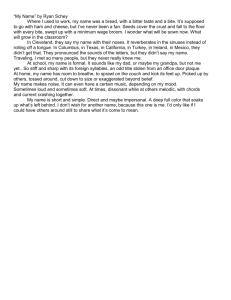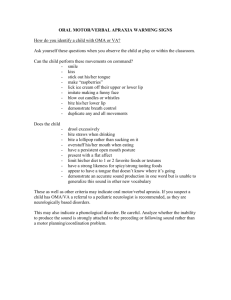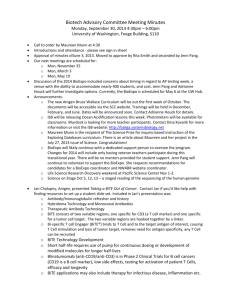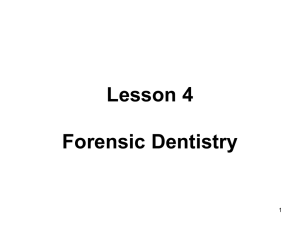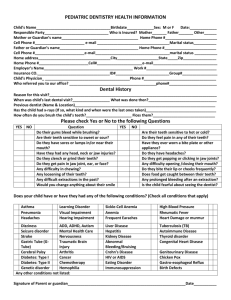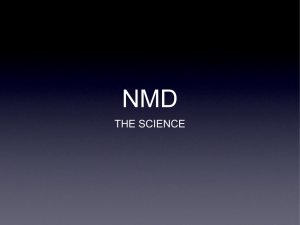Press Release Quotes - Department of Biological Science
advertisement
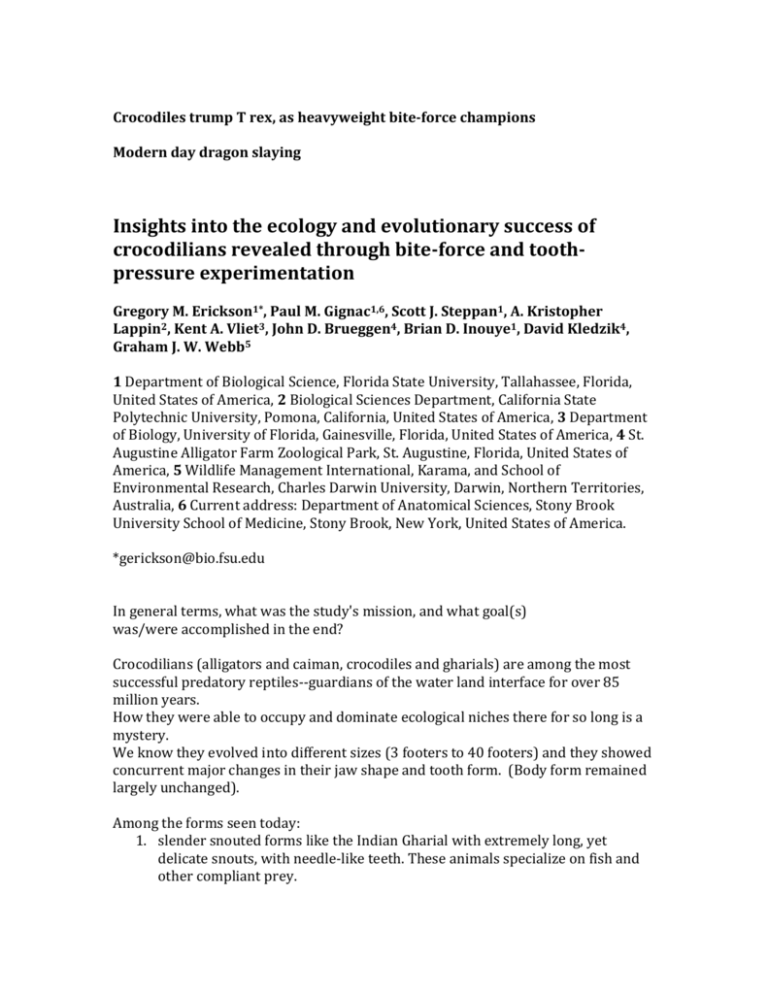
Crocodiles trump T rex, as heavyweight bite-force champions Modern day dragon slaying Insights into the ecology and evolutionary success of crocodilians revealed through bite-force and toothpressure experimentation Gregory M. Erickson1*, Paul M. Gignac1,6, Scott J. Steppan1, A. Kristopher Lappin2, Kent A. Vliet3, John D. Brueggen4, Brian D. Inouye1, David Kledzik4, Graham J. W. Webb5 1 Department of Biological Science, Florida State University, Tallahassee, Florida, United States of America, 2 Biological Sciences Department, California State Polytechnic University, Pomona, California, United States of America, 3 Department of Biology, University of Florida, Gainesville, Florida, United States of America, 4 St. Augustine Alligator Farm Zoological Park, St. Augustine, Florida, United States of America, 5 Wildlife Management International, Karama, and School of Environmental Research, Charles Darwin University, Darwin, Northern Territories, Australia, 6 Current address: Department of Anatomical Sciences, Stony Brook University School of Medicine, Stony Brook, New York, United States of America. *gerickson@bio.fsu.edu In general terms, what was the study's mission, and what goal(s) was/were accomplished in the end? Crocodilians (alligators and caiman, crocodiles and gharials) are among the most successful predatory reptiles--guardians of the water land interface for over 85 million years. How they were able to occupy and dominate ecological niches there for so long is a mystery. We know they evolved into different sizes (3 footers to 40 footers) and they showed concurrent major changes in their jaw shape and tooth form. (Body form remained largely unchanged). Among the forms seen today: 1. slender snouted forms like the Indian Gharial with extremely long, yet delicate snouts, with needle-like teeth. These animals specialize on fish and other compliant prey. 2. Short, flat, broad snouted forms like the Broad Snouted caiman of South America with bulbous teeth specialized for feeding on mollusks and other hard prey. 3. Forms like the American Alligator and Saltwater crocodile of Australia with intermediate width snouts and intermediate sharp teeth that are dietary generalists—they feed on fish, crustaceans, frogs, birds, and mammals, inlc large game such as deer and wildebeests and people (in large adults of large species). 4. There are small species such as dwarf caiman with short but tall snouts like dogs with intermediate width teeth. They are also generalists but also feed on land for rats and porcupines at night. We set out to answer how this anatomical variance related to their ability to generate bite force and pressures for feeding in the different forms and thus how they have been so successful. We hoped to use the data to ultimately explore bite force and tooth pressure performance in fossil forms. A long held notion is that the slender snouted forms would have low bite force and the more robust forms high bite forces. What those numbers might be was a mystery, since only the alligator had been tested previously in adults—by us at FSU. The affects of body size differences on bite forces have not been speculated on, in living or fossil crocs. Nor have tooth pressures--critical for puncturing through their prey and prey parts like bones and shells. Why have these not been tested previously?—the work is dangerous, requires, expensive high tech testing equipment—engineering designed bite force transducers that are waterproof and croc proof, teams of experienced crocodile handlers, the animals are very rare (most are endangered or threatened in the wild) , only one zoological park (St. Augustine Alligtator Farm Zoological park) has every species (n = 23) Over the 11 years over which this study took place (in the US and Australia) we roped the animals (87 adults) in their pools, pulled them out, quickly strapped them down and placed the bite force device between their back teeth and recorded the bite force. An engineering calculation was used to estimate the force generated simultaneously at the other tooth positions nearer in the front of the jaws. We molded the teeth with dentist’s dental putty, made casts of the teeth and figured out the contact areas. The bite force over the contact area is the pressure, which is more pertinent to feeding performance than bite force. It tells us what they were doing with their prodigious bite forces. This whole study took ten years. All crocodilians show pound for pound comparable maximal bite-force capacity (size matters above all else). The snout and tooth strength is inconsequential. They basically all have the same musculo-skeletal design, just different snouts and teeth. “It is analogous to putting different attachments on a weed eater—grass cutter, brush cutter, chain saw, they all have the same engine and horsepower. There are bigger and smaller engines, with higher and lower horsepower, but they have the same kinds of attachments.” Our value of 3,700 lbs for a 17 foot saltwater crocodile is the highest bite force ever recorded---beating a 2980 value for a 13 foot wild American alligator and eclipsing the 1000 lb value for the spotted hyena, the bone crushing champion among carnivoran mammals (lions are estimated to do the same). “If you can bench press a pickup truck you can escape a crocs jaws. It is a one way street between the teeth and stomach of a large croc.” Because the relationship is so tight among the animals with size we can predict values in any crocodile including fossil forms or recently extirpated forms. eg. The largest saltwater crocs in the wild (at 20 feet) are predicted to have generated bite force of 7700 lbs. The 40 foot giants from the past generated 23,100 lbs! “That is like setting a Mac truck on the jaws.” This eclipes the bite fore estimate reported just two weeks ago for T rex –the Tyrant Lizard King”(12,800 lbs). “Move over T rex, the real bite force kings were crocodiles” We have been contacted by the Guiness Book of World Records inquiring about our data. Crocodilian tooth pressures are remarkably high as well. All crocs show higher values than the highest ever measured or estimated in any creature. The old record was 21, 321 psi (lbs per square inch) in a giant fossil fish. We recorded values up to 17-fold higher. Our highest value was 358,678 psi in the Saltwater crocodile. All species can bite through bone, the strongest of the hard items they consume. We think this is was critical to their long term success. Scott Steppan’s phylogenetic analyses (evolutionary patterns) show how these patterns have basically been present throughout the 85 million year evolution of these animals. It was snout and size changes that were the secret to their success. “I refer to our largest bite force meter as an expensive ($11,000) bathroom scale, since it mimics the design of the best bathroom scales”. Where did the funding come for this study? Nat Geo Society and the College of Arts and Science. “I have to admit, the first time a place our meter into the maw of an adult crocodile I was nervous…nervous for our shiny new equipment, nervous for my well-being. No one new what to expect. It was all over in the blink of an eye. When it struck it nearly wrested my grip from the handle. The noise of the jaws coming together was like a gunshot. The power of the animal was astounding, and the violence of the event frightening. The loud oohs and aahs of the crew and bystanders added to confusion…….And then it was over. The next thing I knew the croc is sitting there in freeze frame, seemingly at peace as if nothing has happened. I realize I am in one piece, and so is the bite meter… gripped between the reptile’s teeth that have deeply sunk into the protective layers of bullhide. I ask my graduate student if we recorded a reading? The response is yes, followed by an energetic shouting out of some outrageous number in the thousands of pounds. It worked! We have since repeated this process on over 1000 specimens including the 83 animals for this particular study. The thrill, awe and nervousness, never goes away. “ “Molding a crocodile’s teeth is always scary. They flinch and clamp down on the board when you touch their teeth. It is disconcerting to know that they can bite down faster than you can remove your hands. You pray that the board holds.” “I thought crocodilians were amazing animals before we started this work. That is a large reason I am interested in them. If you can quantify magnificence, I would say we pulled it off”. “This research benefitted from the generous access to specimens and assistance from staff from the St Augustine Alligator Farm Zoological Park—the only facility in the world with every species of crocodilian. The proximity to the park is one of the primary reasons I chose to come to FSU. Crocodylus Park in Australia provided similar assistance with regard to accessing additional large adult saltwater and freshwater crocodiles. “
